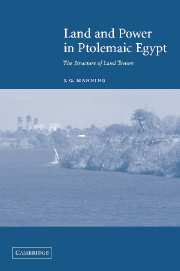Book contents
- Frontmatter
- Contents
- List of maps, figures and tables
- Preface
- Abbreviations
- Units of measure
- Maps
- Part I ISSUES AND HISTORICAL BACKGROUND
- Chapter 1 Issues and methodologies
- Chapter 2 The Ptolemaic state and its antecedents
- Part II REGIONAL CASE STUDIES OF LAND TENURE
- Part III INTERPRETATION
- Appendix 1 Translation of the Edfu donation text
- Appendix 2 Ptolemaic demotic land transfers from Upper Egypt
- Appendix 3 Translation of P. Amh. gr. 49
- List of references
- Index of sources
- General index
Chapter 2 - The Ptolemaic state and its antecedents
Published online by Cambridge University Press: 22 September 2009
- Frontmatter
- Contents
- List of maps, figures and tables
- Preface
- Abbreviations
- Units of measure
- Maps
- Part I ISSUES AND HISTORICAL BACKGROUND
- Chapter 1 Issues and methodologies
- Chapter 2 The Ptolemaic state and its antecedents
- Part II REGIONAL CASE STUDIES OF LAND TENURE
- Part III INTERPRETATION
- Appendix 1 Translation of the Edfu donation text
- Appendix 2 Ptolemaic demotic land transfers from Upper Egypt
- Appendix 3 Translation of P. Amh. gr. 49
- List of references
- Index of sources
- General index
Summary
The authority of the state was total, of the city-states as of the autocracies, and it extended to everyone who resided within the territorial borders (indeed to everyone who resided wherever its writ ran).
Finley 1999: 154Potentially it should be possible not only to study Ptolemaic agriculture but to study it historically and, as done by Napoleon's savants, to study it regionally, and in doing this to gain some idea of local differences of land-tenure and land-use over the three centuries of Ptolemaic rule.
Crawford 1973: 223I examine in this Chapter the structure of the Ptolemaic state in order to place the land tenure regimes of the Thebaid and the Fayyum into the context of the institutional arrangements of control and taxation. The structure of land tenure in Ptolemaic Egypt was a political response to environmental constraints and to historic pathways of property rights and obligations determined long before the Ptolemies. In areas where these old rights on land existed, the regime did not disturb them, whereas in the newly intensified Fayyum, new modes of tenure and stricter state supervision were established. Three issues will concern me in this chapter: (1) the environmental and geographic setting of Egypt, (2) the precursors of the Ptolemaic state, and (3) the structure and the historical development of the Ptolemaic state itself.
THE FIXITY OF THE GEOGRAPHICAL SETTING
Egypt was one of the richest and most densely populated states in the Mediterranean for most of its ancient history.
- Type
- Chapter
- Information
- Land and Power in Ptolemaic EgyptThe Structure of Land Tenure, pp. 27 - 62Publisher: Cambridge University PressPrint publication year: 2003



